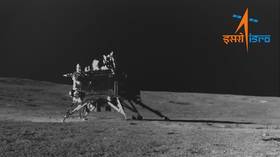China questions India’s historic moon landing
The Chandrayaan-3 mission landed “nowhere near” the lunar south pole, a top scientist in Beijing’s space program has claimed
India’s Chandrayaan-3 did not land at or near the south polar region of the Moon, Chinese scientist Ouyang Ziyuan has argued. With China planning to reach the same region next year, the scientific rivalry between Beijing and New Delhi has heated up.
Chandrayaan-3 touched down on the Moon on August 23 at a latitude of 69 degrees, which Indian scientists say is within the region of the lunar south pole.
“This is wrong,” Ouyang told the Chinese-language Science Times newspaper last week, according to Bloomberg. “The landing site of Chandrayaan-3 is not at the lunar south pole, not in the lunar south pole region, nor is it near the lunar south pole region.”
Ouyang argued that while a latitude of 69 degrees on Earth would be well within the Antarctic circle, the Moon’s smaller axial tilt means that its southern polar region spans between 88.5 and 90 degrees. Under Ouyang’s definition, Chandrayaan-3 landed 619 kilometers (385 miles) away from this region.
Ouyang is a cosmochemist and geochemist, and is considered the father of China’s lunar exploration program.
Regardless of the definition used, Chandrayaan-3 landed further south than any previous moon mission. NASA landed a probe at 41 degrees south in 1968, while China reached 54 degrees south on the far side of the Moon in 2019. An attempt by Russian space agency Roscosmos to land a probe at 69 degrees south failed last month when the Luna-25 lander crashed into the surface of the Moon.
The reaction to the Chandrayaan-3 landing has been mixed in China. The Chinese government did not formally congratulate India on the achievement, and Pang Zhihao, a Beijing-based “senior space expert,” told the state-owned Global Times newspaper that China possesses more advanced rockets and lunar rovers than those used on the Chandrayaan-3 mission.
However, the Global Times also noted that other Chinese scientists have “expressed their sincere congratulations” to New Delhi on the mission.
Although China and India are both members of the Shanghai Cooperation Organisation (SCO) and BRICS group, they are considered geopolitical rivals, and have clashed in recent years over Beijing’s maritime claims in the South China Sea and over their Himalayan border.
The China National Space Administration (CNSA) announced last month that it planned on landing near the lunar south pole next year. According to the CNSA, the Chang’e-6 mission will see a rover dispatched to collect rock samples for transport back to Earth, a feat that only China, the US, and the former Soviet Union have achieved before.
Japan, meanwhile, launched its ‘Moon sniper’ mission last month, hoping to deploy a probe on the celestial body by next year and achieve a “pinpoint landing” within just 100 meters of its target site.
You can share this story on social media:








Comments are closed.